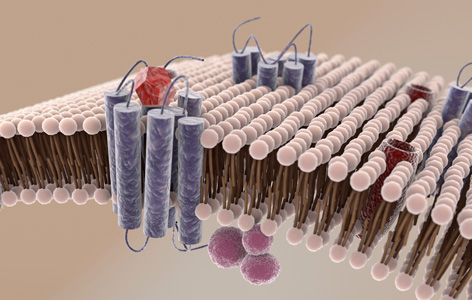
During a heartbeat, electrical signals rapidly travel through heart tissue and instruct each cell to contract. Proteins at regions of the cell membrane known as gap junctions allow the electrical signal to pass between neighbouring cells, leading to concerted contractions.
Although cell membrane proteins are critical in regulating heart function, they have been difficult to study because they are extremely difficult to detect and purify. TGHRI Scientist Anthony Gramolini and PM Cancer Centre Senior Scientist Thomas Kislinger have overcome these challenges and identified a set of cell membrane proteins that regulate how gap junctions are formed.
By refining an existing protein purification method, the researchers were able to isolate more than 500 cell membrane proteins from human heart cells. They then analyzed the structures and functions of these isolated proteins and identified a top candidate protein—known as Tmem65—as a possible regulator of human heart development and function. Analysis of Tmem65 function revealed that it regulates another protein, known as Cx43, to form functional gap junctions. Without Tmem65, Cx43 is broken down and electrical signals in the heart are disrupted.
"By identifying a key role for Tmem65 in gap function biology, these findings provide new insight into cardiac diseases such as arrhythmias, which occur when channels that conduct electrical signals fail to function properly, " explain Drs. Kislinger and Gramolini. "We are now actively studying the functions of other proteins that we identified with the aim of uncovering new therapeutic targets for cardiac disease."
This work was supported by the Heart and Stroke Foundation of Ontario, the Canadian Institutes of Health Research, the Heart and Stroke Richard Lewar Centre of Cardiovascular Excellence, the Ontario Research Fund—Global Leadership Round in Genomics and Life Sciences, the Ontario Genomics Institute, the Canada Foundation for Innovation, the Natural Sciences and Engineering Research Council of Canada, the Canadian Cystic Fibrosis Foundation, the Canadian Cancer Society, Novartis, the German Research Council, the German Federal Ministry for Science and Education, the National Institutes of Health, The Princess Margaret Cancer Foundation and the McEwen Centre for Regenerative Medicine. A Gramolini holds a Tier 2 Canada Research Chair (CRC) in Cardiovascular Proteomics and Molecular Therapeutics, T Kislinger holds a Tier 2 CRC in Proteomics in Cancer Research and G Keller holds a Tier 1 CRC in Embryonic Stem Cell Biology.
Evolutionarily conserved intercalated disc protein Tmem65 regulates cardiac conduction and connexin 43 function. Sharma P, Abbasi C, Lazic S, Teng AC, Wang D, Dubois N, Ignatchenko V, Wong V, Liu J, Araki T, Tiburcy M, Ackerley C, Zimmermann WH, Hamilton R, Sun Y, Liu PP, Keller G, Stagljar I, Scott IC, Kislinger T, Gramolini AO. Nature Communications. 2015 Sep 25. [Pubmed abstract]




